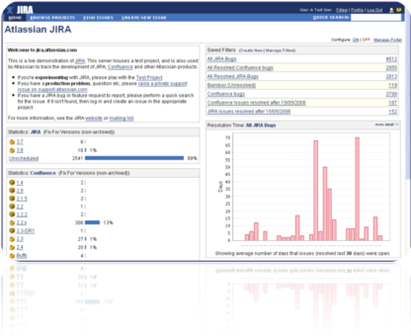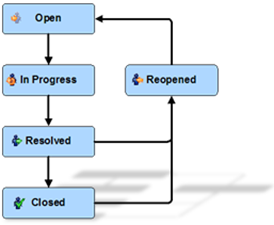 Crikey, where did the time go?
Crikey, where did the time go?
This has been a very busy time for the team with a large number of projects and small alterations coming through as well as RFIs and RFPs (Request For Information / Proposal) to answer. It is at these times when a good issue management tool proves its worth and certainly ours did.
I've talked a lot about the different tools that we've looked at here, but we did finally make a decision, the winner was JIRA from Atlassian (http://www.atlassian.com/software/jira/).
So what was it about JIRA that made it stand out against the, sometimes free, competition? It does what it does well.
Many of the other programs that I looked at tried to do many things, and in my opinion, sometimes meant that it did none of those very well. JIRA doesn't suffer from that. It knows what its supposed to do and it does it well. That's where the final decision lay as far as the team were concerned.
Getting to know JIRA.
I had used JIRA in the past so it was second nature to me, but not yet to the team. There were a couple of language constraints that we had to get past before some of the team could understand the concept. Everything you place in JIRA is an "Issue". It doesn't matter if its a suggestion, a bug, a task, whatever it is, if its in JIRA, then its an "Issue". This is one of the very few things that I could not change in JIRA.
The other area that new users will enjoy getting used to is that nearly everything in JIRA is configurable. At times it seems that everything that is asked for is there within the configuration available to the JRIA Administrator. You will get to understand how such things as Notification Schemes and Permission Schemes work, and you can assign different schemes to different projects.
Projects
 Users or Administrators (depending on what rights the Administrator gives each user or user group) can set up Projects in JIRA and create Issues to the projects. A Project can be either a standard project with a beginning and an end (e.g. a software development project), or an area we can place tasks for normal things needing to be done (e.g. an application or "IT Admin").
Users or Administrators (depending on what rights the Administrator gives each user or user group) can set up Projects in JIRA and create Issues to the projects. A Project can be either a standard project with a beginning and an end (e.g. a software development project), or an area we can place tasks for normal things needing to be done (e.g. an application or "IT Admin").
I have set up the Notification Scheme so that users will get an email when they area assigned to an issue or when someone has added a comment to an issue that is assigned to them. You can set up notifications as you wish. Users can also "watch" particular issues and be emailed whenever anything changes. You can even email JIRA to open a new issue or add a comment and email attachment to an issue.
Issue numbers are related directly to the project via a 3-4 letter prefix. For example, you might have a project called "IT Administration" and a project called "Worldwide Enterprises Project", which will have a prefix of IT and WWE respectively. Issues in IT will start IT-1, IT-2 etc. and issues in WWE will start WWE-1, WWE-2 etc. so it's easy to know what project an issue relates to. You will find the team with a new vocabulary of words like WWE-193 and IT-22 arising in every sentence.
Users can log work against issues and time tracked.
Workflow
 The Enterprise version has a number of tools that allow you to create and change the workflow, however we opted for the standard which uses a good workflow.
The Enterprise version has a number of tools that allow you to create and change the workflow, however we opted for the standard which uses a good workflow.
With the standard, an issue is Open when it is created. Once a developer starts work on it, they can change it to In Progress, unless its a small issue that is completed in less than 30 minutes - they can then just go straight to Resolve.
I have set it so that only myself and QA can Close an issue, but anyone can Reopen it for any reason.
Issues are never deleted, only closed.
Issues can be Resolved in a number of ways and the user is presented with the following in the Standard JIRA, the other JIRA versions allow you to add to or change these :
- Fixed (default) : A fix for this issue has been completed to the satisfaction of the user
- Won’t Fix : The problem described is an issue which will never be fixed (e.g. the issue relates to a previous version and the workaround its to upgrade)
- Duplicate : The problem is a duplicate of an existing issue (user can link the issue to another)
- Incomplete : The problem is not completely described. Used only if the creator of the issue cannot supply any further information (i.e. the creator is no longer available or all attempts to contacted have failed).
Normally, if the problem is not described correctly, it is up to the user to reassign the issue back to the creator with more questions as comments - Cannot Reproduce : All attempts at reproducing this issue failed, or not enough information was available to reproduce the issue. Reading the code produces no clues as to why this behaviour would occur. If more information appears later, the issue may be reopened.
Searching
Users have two ways that they can search for an issue or comment.
"Quick Search" is a seemingly insignificant little search box up the top right of the screen that is extremely powerful. Type anything into there (like "VPN Connection") and JIRA will do a very fast search of all its issues and give you a list of all issues contain that word or phrase. If you know the JIRA number, just type it in and you'll be taken directly to the issue.
"Find Issues" is a menu item that allows you to find issues by creating a Filter. Filters can be created on the fly, saved to a name (e.g. "All Unresolved Development Issues"). JIRA will automatically add a Filter to show you all issues currently assigned to you.
Setting up these Filters is a simple idea of selecting from the list of selections for the fields to search, for example, selecting 1 or more projects to search. Other areas in this search is the Query on the Summary, Description and Comments fields. Query is a reasonably powerful search facility explained Here. Date and time fields have the ability to enter either specific dates, or relative dates (within the last x hours/days, in range from/to). This allows me to, for example, set up a filter to report on all JIRA issues created last month (don't tell my boss that my monthly management reporting is that easy).
When you activate or view a Filter, it shows in a list that you can scroll through and export to Excel or Word, and
Filters can be set up to appear on your JIRA Portal.
The JIRA Portal
The front screen in JIRA can be set up differently by each user. You can add, delete, and move items around the screen to suit yourself. You can add Filters that you created yourself and add pre-set Portlets. These include such things as Project Stats; Admin functions; Filter Stats; My Watched Issues; and Issues in Progress. These can be arranged as you like with the most used Portlets showing at the top of the screen.
My own Portlet shows some details about projects; lists all my save Filters; Overdue Issues; Issues update within the last 8 hours; Resolved issues awaiting me to Close; Issues I'm watching; My assigned issues; and a few of the available graphs that I got from a free JIRA Plugin available from the Atlassian website.
Using JIRA
After using JIRA now for a few months I can honestly say that I have resolved a number of team issues here. I know what is happening; what the team is working on; issues are tracked and comments are added as new information comes in or things are done; the developers and BA can fully understand issues with a place to keep documents, screenshots and comments; work can be prioritised; and everyone can see what work lies ahead of them.
Nothing gets forgotten; work is logged against issues; issues are assigned to others where necessary within the workflow; and management reporting is completed.
The Down Side
 Of course there's a downside - it costs real money. JIRA comes in Standard, Professional and Enterprise editions costing US$1,200, US$2,400 and US$4,800 respectively. While I would have loved the Enterprise edition, we are getting by quite nicely on the Standard edition.
Of course there's a downside - it costs real money. JIRA comes in Standard, Professional and Enterprise editions costing US$1,200, US$2,400 and US$4,800 respectively. While I would have loved the Enterprise edition, we are getting by quite nicely on the Standard edition.
You will have to keep on top of it when you first install it as there is a mind-set that says "I've assigned this issue to someone else, it's no longer my problem". It's also easy to simply ignore issues assigned to you and then get upset when you have hundreds of issues in front of you.
Summary
As I said, "JIRA works". Sometimes it comes down to that. As a Development Manager I can trust it, the developers trust it, and everyone in the company trusts it.
Try it out for free on your server for a month or two. They'll extend the free trial if you ask them nicely, but I don't think you'll need it. It's so nice to find nice people who actually support and use their product themselves.
Just a quick note: I have no affiliation with JIRA\Atlassian . I don't know anyone there and I don't get anything free from them .. although a tee-shirt wouldn't go astray (HINT HINT Atlassian - Grin).





